Let’s talk about hunters in this issue, because I am currently playing a lone wolf hunter. If I play other professions in the future, I may study other professions.

This issue mainly talks about some basic knowledge about hunter pets in the nostalgic server to help novice hunters who have officially served or just entered the game to have a brief understanding.
Hunters in the classic server can only catch babies at level 10, and leveling up from level 1 to level 10 will be very difficult.
After reaching level 10, you will learn to capture babies from the trainer, which will allow you to capture two nearby beasts, and then teach you several skills about babies such as taming beasts and training beasts.
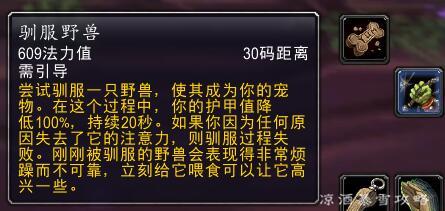
At this time you can catch a beast as your pet.
The pets that can be captured are divided into 17 species: bats, bears, pigs, scavengers, cats, crabs, crocodiles, orangutans, hyenas, wolves, owls, raptors, scorpions, spiders, chocobos, turtles, and wind snakes.
The overall damage of beasts of the same type remains unchanged, the only difference is attack speed and appearance. To put it simply, a pet with a fast attack speed will do low damage, and a pet with a slow attack speed will do high damage. The damage dealt in a certain period of time is the same. For example, if it is the same cat, its attack power is 50 when it attacks once every second, and it attacks once every two seconds. The attack power is 100. If you fight for one minute, both pets will deal 3000 damage. There is no difference.
In pve, the pet damage is the same, but in pvp, the damage taken by the legal profession when reading the bar will reduce the reading progress, so a pet with a fast attack speed will have some advantages in playing the magic profession in pvp, so I like pvp Players can catch a pet with a faster attack speed, but players who don't like pvp don't need to consider this.
There are certain differences in the attributes of pets of different species, and the output skills are also different, as detailed in the following table:
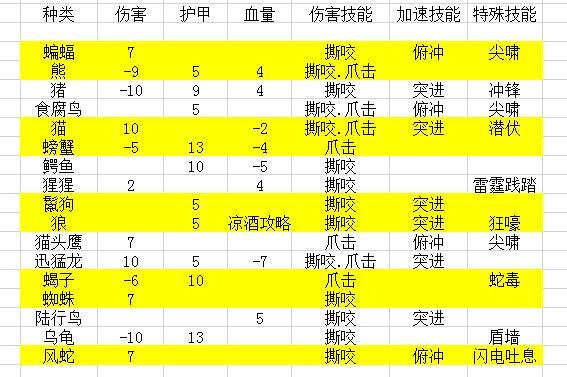
The number is a percentage, a positive number is a percentage more, a negative number is a percentage less, the one without a number is the basic template, for example, the bat's damage +7%, the carrion bird is the basic template, that is, the same level Bats will do 7% more damage than scavengers.
From this table, we can also see that cats or raptors have the highest damage. That is, if you want a pet that focuses on damage, it is best to catch a cat or raptor, and high output means that The body is brittle. If you want a pet that can resist, it is best to choose a bear, pig or turtle.
Your pet will have two important values, mood and loyalty.
The maximum mood is 1000 points. The specific value will not be displayed. Instead, after your pet is summoned, an expression will appear behind its health bar. From low to high, they are red-faced and unhappy (0-333), and yellow-faced and satisfied (333). -666), green face happiness (666-1000), the mood will also affect the damage caused by pets, green face will cause 125% damage.
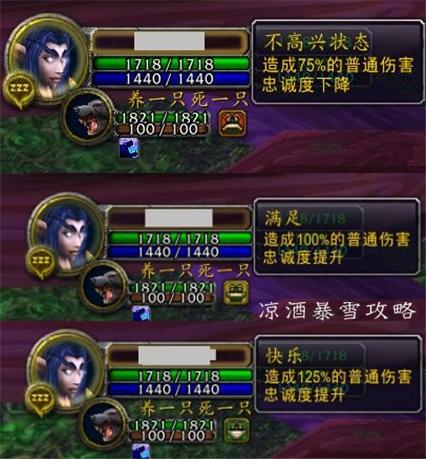
The pet's mood will slowly decrease over time. The better the mood, the slower the decrease. The worse the mood, the faster the decrease. It will also decrease rapidly due to death (a death decreases by 333 points).
The way to improve your mood is to feed food. When you learn to capture pets at level 10, you will be given a [Feed Pets] skill. You can use this skill to feed pets:

Each species of pet has its favorite food. For example, bats only like mushrooms or fruits, wolves only eat meat, and pigs or bears eat everything. After the pet is summoned, you can open the character attribute panel and there will be an additional pet panel below. , place the mouse on the face symbolizing the pet's mood in the upper left corner to see what foods your pet likes:

After feeding the pet's favorite food, the pet will have a "feeding pet effect" buff for 10 seconds, and the movement will not be interrupted. Being beaten or attacked will interrupt the buff in advance, and let the buff last for 10 seconds to obtain the full pet happiness.

It is written in the skill description above that food close to the level of your pet has the best effect. When you feed a food that is not lower than your pet's level 10, you will get a total of 350 happiness in 10 seconds. When you feed a food that is lower than your pet's level, When the food is level 10 or not lower than level 20, a total of 175 happiness will be obtained in 10 seconds, while when the food is lower than level 20, the pet will only get 88 happiness in 10 seconds.
Dismissing a pet will result in a loss of 50 happiness points, but happiness will not be deducted when the pet is automatically dismissed because it is too far away from you.
In terms of emotional faces, red faces indicate a decrease in loyalty, while yellow and green faces indicate an increase in loyalty, which affects the loyalty of pets.
In the pet panel, below the pet's level is the pet's loyalty level, up to level 6:

The newly caught pet will be level 1. You need to feed the pet to yellow face or green face to gradually increase its loyalty. When you summon a pet and keep the yellow or green face, the pet will gain 5% of the experience of upgrading the current level of the character. When summoned for enough time, the pet's loyalty level will increase. At level 1, as long as you get the experience of upgrading the current level of the character. 5% experience will be upgraded to level 2 loyalty. In addition to gaining experience, level 2 also needs to be summoned for at least 30 minutes to upgrade to level 3. 3-4 requires 45 minutes, 4-5 requires 60 minutes, and 5-6 requires 75 minutes.
Loyalty mainly affects the pet's training points. The pet's training points = pet level x (loyalty level - 1). For example, a level 60 and level 6 loyal pet will have 60x (6-1) = 300 training points.
The skills of hunters' pets in the classic server will not improve as the pet upgrades. Instead, you need to learn it and then teach it to your pet. When you are taught to capture pets at level 10, you will be given a skill to train beasts:
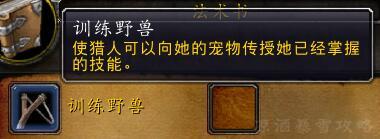
The skills learned by the hunter will be placed here, and then the pet's training points will be consumed to teach them to pets. After being taught to pets, the skills of the hunter will not disappear and can be taught repeatedly to future pets.
There are two ways for hunters to learn pet skills. One is to learn from pet trainers located in various villages, towns and cities. You must reach a certain level and spend a certain amount of money. The pet trainer will only teach you endurance, armor, ice resistance, and dark resistance. , fire kang, natural resistance, these 6 passive skills and low roar (taunt), the pet trainer can also wash the pet skills back to training points.
The level increase amount of endurance and armor, the required pet level, and the consumption of learning degree are as follows:
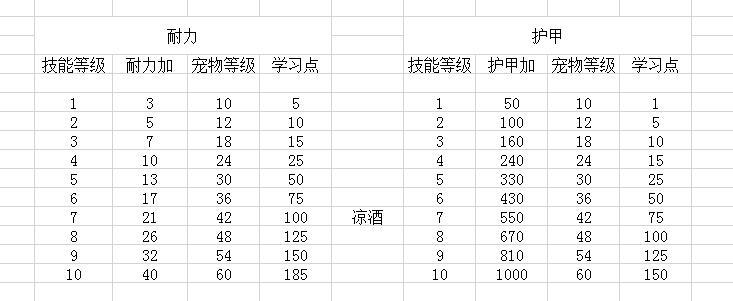
The increase in level of the four resistance skills, the required pet level, and the consumption of learning degrees are as follows. It should be noted that this is the data of a skill:
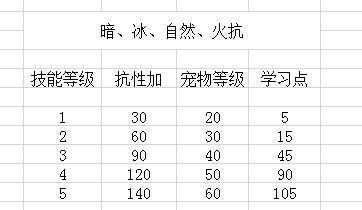
Growl (taunt) pets can learn one level every 10 levels, and can learn 7 levels at level 60 without consuming learning points.
The 7 skills learned from the pet trainer must be learned level by level. That is, you cannot directly learn level 3 without learning level 2. You must learn level by level 123 times.
Pet trainers can only learn these 7 skills, and the rest of the skills need to be learned from the pets you capture.
Because a hunter can only carry one kind of pet, when you carry a pet, you cannot capture a pet unless it is with the stable manager or the pet is released (irreversible).
When you have no pets on you, you can capture new pets to learn the skills of the new pets. You can use the skill [Beast Knowledge] to look at the beasts to see what skills you can learn by capturing the pet:

For example, the Gray Valley Bear above can get claw attack (level 3), then I will tame this bear. After taming it, let it use this skill a few times, and you will see the chat bar prompt that you have learned a new skill:
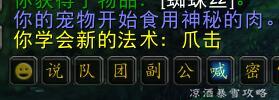
At this time, we can give up this pet, then bring back the pet in the animal pen, and teach the pet in the animal pen the level 3 claw attack we just learned.
Skills learned from captured beasts can be learned by skipping levels. That is, my original pet only had level 1 claw attack. Now that I have learned level 3 claw attack, I can directly learn level 3 claw attack for my pet.
Although these skills can be learned by skipping levels, the learning points actually consumed are the same, that is, the learning points consumed by letting a pet directly learn level 3 claw attacks are the same as learning level 123 claw attacks step by step.
Some high-level beasts will have some high-level skills after being caught. These skills are not given for free, but take up learning points. As mentioned above, a fully loyal pet at level 60 will have 300 learning points. Skills will take up part of the learning points, which can be washed away at the pet trainer.
The following are the skill levels, effects, required pet levels, etc. that can be learned from beasts. There are more beasts that can be learned than those in the table. There are actually many kinds of beasts that can be learned at each level. Here are just two common beasts for each type. example.
The learning points of each level skill represent the skill points required to directly learn this skill. As mentioned above, although you can skip level learning, the actual points consumed are the same. For example, level 8 claw attack requires 25 learning points, so no matter you are Whether to directly learn level 8 claw attack for a pet with 300 learning points and no skills, or to learn level 8 claw attack for a pet that already has level 7 claw attack. After learning, the pet will still have 275 learning points left. The difference is that directly learn level 8 claw attack. Level 8 Claw Strike requires 25 learning points, while a pet that already has Level 7 Claw Strike only has 279 learning points, and learning Claw Strike only requires 4 learning points.
Which types of pets can learn these skills can be found in my first table at the top.
Claw attack, 25 focus value, no CD:
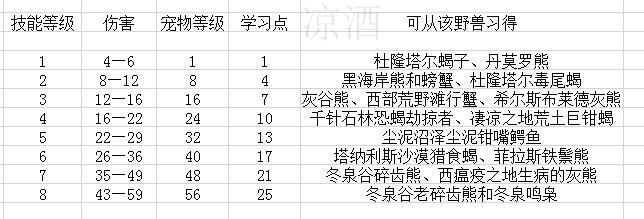
Bite, 25 concentration value, 10 seconds CD:
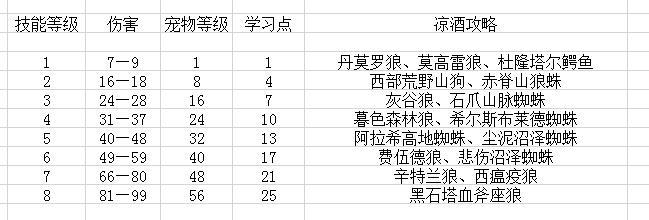
Cowering, 25 concentration value, 5 seconds CD, reduces hatred, is the opposite of Growling and has a total CD:

Rush and dive, 20 concentration value, 30cd, increased movement speed within 15 seconds after use:

Charge (pig only), 35 concentration value, 8-25 yards, 25 seconds CD, immobilizes the target for 1 second and increases the damage of the next attack:

Howl (Wolf only), 60 concentration value, 10 seconds CD, increases the damage of the next attack of teammates within 15 yards.
Sneaking (cat only), 40 focus, 10 seconds CD, sneaking and increasing the damage of the next attack:

Lightning Breath (Wind Serpent only), 50 concentration value, attacks single target:

Scorpion venom (scorpions only), 30 concentration value, 4 seconds CD, inflicts a dot on a single target that lasts 10 seconds, can be stacked 5 times:

Scream, 20 concentration value, 4 seconds CD, causes damage to a single target and reduces the attack strength of enemies in melee range:

Thunder trample (gorilla only), 60 concentration value, 60 seconds CD, AOE damage to enemies within 8 yards:

Carapace shield (turtle only), 10 concentration value, 180 seconds CD, 50% reduction in damage received within 12 seconds, but at the same time it will increase the attack interval by 43%. It is only available at level 1 and can be learned at level 20. It has 15 learning points and can be obtained in Xi Learned from the tortoises of Elsblad or the Hinterlands.